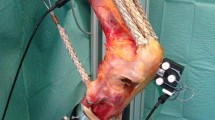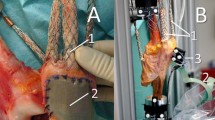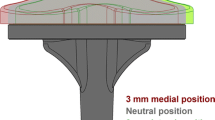Abstract
Introduction
Patellofemoral complications are one major concern after total knee arthroplasty (TKA). Anterior knee pain is one of these complications and to a high percentage responsible for unsatisfied patients after TKA. Malrotation of the femoral component can contribute to retropatellar peak pressure and consequently to anterior knee pain.
Materials and methods
Eight fresh frozen cadavers were tested in a force-controlled knee rig after TKA during isokinetic flexing of the knee from 20° to 120° under constant load. By tilting the trochlea in the material of the created femoral component replicas, a rotation of the femoral component by 3° internal, 0° (neutral), 3° and 6° external rotation to transepicondylar line was simulated without changing flexion or extension gap. Retropatellar pressure distribution was measured during flexion and extension of the knee while quadriceps muscles and hamstring forces were applied.
Results
Maximum peak pressure for internal rotation of the trochlea was 7.32 ± 2.31 MPa, in neutral position the pressure reduced slightly to 7.31 ± 2.12 MPa and during further external rotation of trochlea rotation a decrease from 3° with 7.18 ± 2.14 MPa to 6° with 6.22 ± 1.83 MPa was observed (p < 0.01). There was a tendency of lower quadriceps force with increasing external rotation of the trochlea (p = 0.08).
Conclusions
The implantation of the femoral component by 3° internal trochlea rotation to transepicondylar line resulted in a highly significant increase of the mean maximal retropatellar pressure compared to 6° external rotation of the trochlea of the femoral component (p < 0.01). A higher retropatellar pressure might lead to anterior knee pain after TKA. We recommend an external rotation of the femoral component between 3° and 6° to anatomical transepicondylar line to reduce the maximal retropatellar pressure, but only if adequate soft tissue balancing and stable knee kinematics are provided.





Similar content being viewed by others
References
Bourne RB, Chesworth BM, Davis AM, Mahomed NN, Charron KD (2010) Patient satisfaction after total knee arthroplasty: who is satisfied and who is not? Clin Orthop Relat Res 468(1):57–63
Boyd AD Jr, Ewald FC, Thomas WH, Poss R, Sledge CB (1993) Long-term complications after total knee arthroplasty with or without resurfacing of the patella. J Bone Joint Surg Am 75(5):674–681
Barrack RL, Bertot AJ, Wolfe MW, Waldman DA, Milicic M, Myers L (2001) Patellar resurfacing in total knee arthroplasty. A prospective, randomized, double-blind study with five to seven years of follow-up. J Bone Joint Surg Am 83-A(9):1376–1381
Robertsson O, Knutson K, Lewold S, Lidgren L (2001) The Swedish Knee Arthroplasty Register 1975-1997: an update with special emphasis on 41,223 knees operated on in 1988-1997. Acta Orthop Scand 72(5):503–513
Springorum HR, Rath B, Baier C, Lechler P, Luring C, Grifka J (2011) Patellofemoral pain after total knee arthroplasty: clinical pathway and review of the literature. Orthopade 40(10):907–911
Kulkarni SK, Freeman MA, Poal-Manresa JC, Asencio JI, Rodriguez JJ (2000) The patellofemoral joint in total knee arthroplasty: is the design of the trochlea the critical factor? J Arthroplasty 15(4):424–429
Hauf W, Mittlmeier T, Hagena FW, Plitz W (1992) Method for in vivo measurement of intraosseous pressure of the patella. Biomed Tech (Berl) 37(11):263–272
Stukenborg-Colsman C, Ostermeier S, Burmester O, Wirth CJ (2003) Dynamic in vitro measurement of retropatellar pressure after knee arthroplasty. Orthopade 32(4):319–322
Fuchs S, Skwara A, Tibesku CO, Rosenbaum D (2005) Retropatellar contact characteristics before and after total knee arthroplasty. Knee 12(1):9–12
Fuchs S, Schutte G, Witte H (1999) [Effect of knee joint flexion and femur rotation on retropatellar contact of the human knee joint]. Biomed Tech (Berl) 44(12):334–338
Ahmed AM, Duncan NA (2000) Correlation of patellar tracking pattern with trochlear and retropatellar surface topographies. J Biomech Eng 122(6):652–660
Barink M, Meijerink H, Verdonschot N, van Kampen A, de Waal Malefijt M (2007) Asymmetrical total knee arthroplasty does not improve patella tracking: a study without patella resurfacing. Knee Surg Sports Traumatol Arthrosc 15(2):184–191
Rhoads DD, Noble PC, Reuben JD, Tullos HS (1993) The effect of femoral component position on the kinematics of total knee arthroplasty. Clin Orthop Relat Res 286:122–129
Anouchi YS, Whiteside LA, Kaiser AD, Milliano MT (1993) The effects of axial rotational alignment of the femoral component on knee stability and patellar tracking in total knee arthroplasty demonstrated on autopsy specimens. Clin Orthop Relat Res 287:170–177
Berger RA, Crossett LS, Jacobs JJ, Rubash HE (1998) Malrotation causing patellofemoral complications after total knee arthroplasty. Clin Orthop Relat Res 356:144–153
Barrack RL, Schrader T, Bertot AJ, Wolfe MW, Myers L (2001) Component rotation and anterior knee pain after total knee arthroplasty. Clin Orthop Relat Res 392:46–55
Murakami AM, Hash TW, Hepinstall MS, Lyman S, Nestor BJ, Potter HG (2012) MRI evaluation of rotational alignment and synovitis in patients with pain after total knee replacement. J Bone Joint Surg Br 94(9):1209–1215
Miller MC, Berger RA, Petrella AJ, Karmas A, Rubash HE (2001) Optimizing femoral component rotation in total knee arthroplasty. Clin Orthop Relat Res 392:38–45
Kellgren JH, Lawrence JS (1957) Radiological assessment of osteo-arthrosis. Ann Rheum Dis 16(4):494–502
Steinbrück A, Schröder C, Woiczinski M, Fottner A, Müller PE, Jansson V (2013) Patellofemoral contact patterns before and after total knee arthroplasty: an in vitro measurement. Biomed Eng Online 12:58
Victor J (2009) Rotational alignment of the distal femur: a literature review. Orthop Traumatol Surg Res 95(5):365–372
Bourne RB, Chesworth BM, Davis AM, Mahomed NN, Charron KD (2010) Patient satisfaction after total knee arthroplasty: who is satisfied and who is not? Clin Orthop Relat Res 468:57–63
Hauschild O, Muenzberg M, Knothe D, Konstantinidis L, Helwig P, Sudkamp NP, Thielemann FW (2013) Rotational limb alignment changes following total knee arthroplasty. Knee Surg Sports Traumatol Arthrosc 21(10):2346–2354
Acknowledgments
The authors thank the Dr. Auguste Schaedel-Dantscher Foundation for their financial support of this study. The authors also thank the Aesculap Company for providing the prosthesis system, construction of the replicas of the femoral component and set of tools. We also thank Dr. Alexander Crispin (Institute for Biometry and Bioinformatics, LMU München) for his help in generating the statistical tests in this study. Additionally the authors thank Moritz von Holst for his technical help in preparing this paper.
conflict of interest
None.
Author information
Authors and Affiliations
Corresponding author
Rights and permissions
About this article
Cite this article
Steinbrück, A., Schröder, C., Woiczinski, M. et al. The effect of trochlea tilting on patellofemoral contact patterns after total knee arthroplasty: an in vitro study. Arch Orthop Trauma Surg 134, 867–872 (2014). https://doi.org/10.1007/s00402-014-1956-1
Received:
Published:
Issue Date:
DOI: https://doi.org/10.1007/s00402-014-1956-1




